Papers by Andreas Schulze

Scientific Reports, Dec 15, 2023
Cellular homeostasis of creatine (CT), integral part of the energy buffering and transducing syst... more Cellular homeostasis of creatine (CT), integral part of the energy buffering and transducing system connecting intracellular sites of ATP production and utilization, comprises of mechanisms that increase CT, i.e., biosynthesis and cellular uptake, and CT-lowering processes, such as export and nonenzymatic conversion to creatinine. The biosynthesis of CT is controlled by negative feedback loop via suppression of the rate-limiting enzyme arginine:glycine amidinotransferase (AGAT). Although the regulatory mechanism involved is not well understood, AGAT suppression is successfully used in patients with guanidinoacetate methyltransferase (GAMT) deficiency to reduce the neurotoxic accumulation of the AGAT-mediated guanidinoacetate production by supplementing patients with CT. Utilizing the CT-dependent feedback loop for the upregulation of AGAT expression may well represent a therapeutic target for an additional CT deficiency syndrome, the CT transporter (CrT) defect, for which no effective treatment option is available so far. We have used CRISPR to tag the C-terminus of AGAT with a nanoluc luciferase (NLuc) reporter in HAP1 cells. A biphasic decay of AGAT-NLuc in response to increasing extracellular CT was observed, whereas the decrease in AGAT-NLuc expression was directly proportional to the rise in intracellular CT levels with an approximate IC50 of 1-2 mM. CRISPR generated HAP1 CrT null cells and HAP1 CrT null cells stably expressing a CrT-GFP fusion protein further demonstrated that the biphasic response to extracellular CT is mediated by a high-affinity (Km 9-10 µM) CrT dependent, saturable mechanism and a CrT independent, unsaturable uptake process. The direct response to intracellular CT suggests the existence of an intracellular CT sensing system enabling a dynamic cell response to changing CT concentration that is relevant for cellular CT homeostasis. Abbreviations AGAT-NLuc Endogenous AGAT gene tagged at the c-terminus (coded by exon 9) with Nluc CrT Creatine transporter SLC6A8 CrT WT HAP1 wild type cell line expressing the creatine transporter CrT KO HAP1 creatine transporter knockout line CrT-GFP Overexpressed CrT with in frame C-terminal GFP. Expression from stably integrated CMV CrT GFP plasmid construct CT Creatine CycCT Cyclocreatine FBS Fetal bovine serum HDR Homology directed repair IC50 Half-maximal inhibition constant
Bundesgesundheitsblatt - Gesundheitsforschung - Gesundheitsschutz
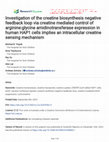
Cellular homeostasis of creatine (CT), integral part of the energy buffering and -transducing sys... more Cellular homeostasis of creatine (CT), integral part of the energy buffering and -transducing system connecting intracellular sites of ATP production and -utilization, comprises of mechanisms that increase CT, i.e., biosynthesis and cellular uptake, and CT-lowering processes, such as export and non-enzymatic conversion to creatinine. The negative feedback loop by which CT controls its biosynthesis via suppression of the rate-limiting enzyme arginine:glycine amidinotransferase (AGAT) is not well understood. We have used CRISPR to tag the C-terminus of AGAT with a nanoluc luciferase (NLuc) reporter in HAP1 cells. A biphasic decay of AGAT-NLuc in response to increasing extracellular CT was observed, whereas the decrease in AGAT-NLuc expression was directly proportional to the rise in intracellular CT levels with an approximate IC50 of 1–2 mM. CRISPR generated HAP1 CT transporter (CrT) null cells and HAP1 CrT null cells stably expressing a CrT-GFP fusion protein further demonstrated tha...

Amino Acids, 2016
Deficiency of guanidinoacetate methyltransferase (GAMT) causes creatine depletion and guanidinoac... more Deficiency of guanidinoacetate methyltransferase (GAMT) causes creatine depletion and guanidinoacetate accumulation in brain with the latter deemed to be responsible for the severe seizure disorder seen in affected patients. We studied electrical brain activity and GABAA mediated mechanisms of B6J.Cg-Gamttm1Isb mice. Electrocorticographic (ECoG) monitoring of pharmacological treatments with ornithine (5 % in drinking water for 5–18 days) and/or Picrotoxin (PTX) (a GABAA receptor antagonist) (1.5 mg/kg, I.P.) in GamtMUT and GamtWT groups [n = 3, mean age (SEM) = 6.9 (0.2) weeks]. Mice were fitted with two frontal and two parietal epidural electrodes under ketamine/xylazine anesthesia. Baseline and test recordings were performed for determination of seizure activity over a 2 h period. The ECoG baseline of GamtMUT exhibited an abnormal monotonous cortical rhythm (7–8 Hz) with little variability during awake and sleep states compared to wild type recordings. Ornithine treatment and also PTX administration led to a relative normalization of the GamtMUT ECoG phenotype. GamtWT on PTX exhibited electro-behavioral seizures, whereas the GamtMUT did not have PTX induced seizures at the same PTX dose. GamtMUT treated with both ornithine and PTX did not show electro-behavioral seizures while ornithine elevated the PTX seizure threshold of GamtMUT mice even further. These data demonstrate: (1) that there is expression of electrical seizure activity in this Gamt-deficient transgenic mouse strain, and (2) that the systemic availability of guanidinoacetate affects GABAA receptor function and seizure thresholds. These findings are directly and clinically relevant for patients with a creatine-deficiency syndrome due to genetic defects in GAMT and provide a rational basis for a combined ornithine/picrotoxin therapeutic intervention.

Genetics in Medicine
RABGAP1 is a GTPase-activating protein implicated in a variety of cellular and molecular processe... more RABGAP1 is a GTPase-activating protein implicated in a variety of cellular and molecular processes, including mitosis, cell migration, vesicular trafficking, and mTOR signaling. There are no known Mendelian diseases caused by variants in RABGAP1. Methods: Through GeneMatcher, we identified 5 patients from 3 unrelated families with homozygous variants in the RABGAP1 gene found on exome sequencing. We established lymphoblastoid cells lines derived from an affected individual and her parents and performed RNA sequencing and functional studies. Rabgap1 knockout mice were generated and phenotyped. Results: We report 5 patients presenting with a common constellation of features, including global developmental delay/intellectual disability, microcephaly, bilateral sensorineural hearing loss, and seizures, as well as overlapping dysmorphic features. Neuroimaging revealed common features, including delayed myelination, white matter volume loss, ventriculomegaly, and thinning of the corpus callosum. Functional analysis of patient cells revealed downregulated mTOR signaling and abnormal localization of early endosomes and lysosomes. Rabgap1 knockout mice exhibited several features in common with the patient cohort, including microcephaly, thinning of the corpus callosum, and ventriculomegaly. Conclusion: Collectively, our results provide evidence of a novel neurodevelopmental syndrome caused by biallelic loss-of-function variants in RABGAP1.

<p>HeLa cells stably expressing firefly luciferase under control of <i>NDST1</i>... more <p>HeLa cells stably expressing firefly luciferase under control of <i>NDST1</i> promoter were treated with compounds from the Prestwick Chemical Library. The reporter activity of the tested compounds is expressed relative to the mean activity of DMSO treated cells. Drugs showing cytotoxic effects, as tested in parallel by the Hexosaminidase assay, were removed from the graph. Thirty eight compounds resulting in the luminescence decrease by >75% relative to the mean of DMSO control were considered as potentially strong <i>NDST1</i> inhibitors (shown in red). Seven compounds (shown in green) increased luminescence by ≥ 30% over the mean DMS control. These compounds could be considered as potential inducers of <i>NDST1</i> expression. Eight potentially strong inhibitors and 2 average inhibitors (indicated by blue circles) were selected for the dose-response assessment (<a href="http://www.plosone.org/article/info:doi/10.1371/journal.pone.0162145#pone.0162145.g004" target="_blank">Fig 4A</a>). Experiments were performed in triplicates. Abbreviation: stdev–standard deviation.</p

Journal of Inherited Metabolic Disease, 2020
Arginine:glycine amidinotransferase‐ and guanidinoacetate methyltransferase deficiency are severe... more Arginine:glycine amidinotransferase‐ and guanidinoacetate methyltransferase deficiency are severe neurodevelopmental disorders. It is not known whether mouse models of disease express a neuroanatomical phenotype. High‐resolution magnetic resonance imaging (MRI) with advanced image analysis was performed in perfused, fixed mouse brains encapsulated with the skull from male, 10‐12 week old Agat ‐exc and B6J.Cg‐Gamt tm1Isb mice (n = 48; n = 8 per genotype, strain). T2‐weighted MRI scans were nonlinearly aligned to a 3D atlas of the mouse brain with 62 structures identified. Local differences in brain shape related to genotype were assessed by analysis of deformation fields. Creatine (Cr) and guanidinoacetate (GAA) were measured with high‐performance liquid chromatography (HPLC) in brain homogenates (n = 24; n = 4 per genotype, strain) after whole‐body perfusion. Cr was decreased in the brain of Agat‐ and Gamt mutant mice. GAA was decreased in Agat−/− and increased in Gamt−/−. Body weig...
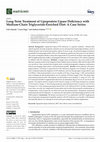
Nutrients
Background: Lipoprotein lipase (LPL) deficiency is a genetic condition. Affected individuals typi... more Background: Lipoprotein lipase (LPL) deficiency is a genetic condition. Affected individuals typically develop symptoms related to severe and persistent hypertriglyceridemia, such as abdominal pain and recurrent pancreatitis, before 10 years of age. No pharmacological treatment sustainably lowering triglycerides (TGs) in LPL deficiency patients has been proven to be effective. This study investigated whether a long-chain triglyceride (LCT)-restricted, medium-chain triglyceride (MCT)-supplemented diet enables a meaningful reduction in TGs and reduces LPL-related symptoms in children with LPL deficiency. Methods: A single-center retrospective case series study of LPL deficiency patients treated at the Hospital of Sick Children between January 2000 and December 2022 was carried out. Data, extracted from hospital charts, included demographics, diagnosis confirmation, clinical and imaging observations, and biochemical profiles. Results: Seven patients with hypertriglyceridemia > 20 mm...

Genes, 2021
Identifying multiple ultra-rare genetic syndromes with overlapping phenotypes is a diagnostic con... more Identifying multiple ultra-rare genetic syndromes with overlapping phenotypes is a diagnostic conundrum in clinical genetics. This study investigated the pathogenicity of a homozygous missense variant in GNB5 (GNB5L; NM_016194.4: c.920T > G (p. Leu307Arg); GNB5S; NM_006578.4: c.794T > G (p. Leu265Arg)) identified through exome sequencing in a female child who also had 3-methylcrotonyl-CoA carboxylase (3-MCC) deficiency (newborn screening positive) and hemoglobin E trait. The proband presented with early-onset intellectual disability, the severity of which was more in keeping with GNB5-related disorder than 3-MCC deficiency. She later developed bradycardia and cardiac arrest, and upon re-phenotyping showed cone photo-transduction recovery deficit, all known only to GNB5-related disorders. Patient-derived fibroblast assays showed preserved GNB5S expression, but bioluminescence resonance energy transfer assay showed abolished function of the variant reconstituted Gβ5S containing ...
Journal of Inherited Metabolic Disease, 1998
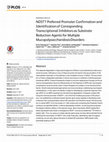
PloS one
The stepwise degradation of glycosaminoglycans (GAGs) is accomplished by twelve lysosomal enzymes... more The stepwise degradation of glycosaminoglycans (GAGs) is accomplished by twelve lysosomal enzymes. Deficiency in any of these enzymes will result in the accumulation of the intermediate substrates on the pathway to the complete turnover of GAGs. The accumulation of these undegraded substrates in almost any tissue is a hallmark of all Mucopolysaccharidoses (MPS). Present therapeutics based on enzyme replacement therapy and bone marrow transplantation have low effectiveness for the treatment of MPS with neurological complications since enzymes used in these therapies are unable to cross the blood brain barrier. Small molecule-based approaches are more promising in addressing neurological manifestations. In this report we identify a target for developing a substrate reduction therapy (SRT) for six MPS resulting from the abnormal degradation of heparan sulfate (HS). Using the minimal promoter of NDST1, one of the first modifying enzymes of HS precursors, we established a luciferase base...
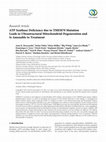
BioMed Research International, 2015
TMEM70 is involved in the biogenesis of mitochondrial ATP synthase and mutations in theTMEM70gene... more TMEM70 is involved in the biogenesis of mitochondrial ATP synthase and mutations in theTMEM70gene impair oxidative phosphorylation. Herein, we report on pathology and treatment of ATP synthase deficiency in four siblings. A consanguineous family of Roma (Gipsy) ethnic origin gave birth to 6 children of which 4 were affected presenting with dysmorphic features, failure to thrive, cardiomyopathy, metabolic crises, and 3-methylglutaconic aciduria as clinical symptoms. Genetic testing revealed a homozygous mutation (c.317-2A>G) in theTMEM70gene. While light microscopy was unremarkable, ultrastructural investigation of muscle tissue revealed accumulation of swollen degenerated mitochondria with lipid crystalloid inclusions, cristae aggregation, and exocytosis of mitochondrial material. Biochemical analysis of mitochondrial complexes showed an almost complete ATP synthase deficiency. Despite harbouring the same mutation, the clinical outcome in the four siblings was different. Two chil...
Clinical Biochemistry, 2014
Molecular Genetics and Metabolism, 2013
are/were employees of Hyperion at the time of the study. D. Milikien is an employee of Accudata, ... more are/were employees of Hyperion at the time of the study. D. Milikien is an employee of Accudata, which was paid by Hyperion to perform the biostatistical analyses. None of the other authors have a financial interest in Hyperion, although payments were made by Hyperion to all investigators for services related to the clinical trials.
Journal of Inherited Metabolic Disease, 2009
A 12-year-old girl presented with severe deterioration in vision over several months, worse in th... more A 12-year-old girl presented with severe deterioration in vision over several months, worse in the right eye. On examination, she was unable to count fingers or perceive light using her right eye, and the red reflex was absent (Fig. 1). Funduscopy showed a chronic retinal detachment and severe chorioretinal atrophy with punched-out lesions in the periphery of the retina, consistent with gyrate atrophy. Similar but milder J Inherit Metab Dis DOI 10.1007/s10545-009-1220-y
European Journal of Pediatrics, 1996
We report on two siblings, Key words Methylmalonic aciduria. Vitamin B12. GABA. Cerebrospinal flu... more We report on two siblings, Key words Methylmalonic aciduria. Vitamin B12. GABA. Cerebrospinal fluid 9 Encephalomyelopathy Abbreviations Ado-Cbl adenosylcobalamin 9 GABA Taminobutyric acid 9 GC-MS gas chromatography-mass spectrometry 9 OH-Cbl hydroxocobalamin
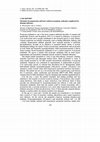
Journal of Inherited Metabolic Disease, 1999
acidaemia is one of the more common inherited disorders of organic acid Propionic metabolism (Fen... more acidaemia is one of the more common inherited disorders of organic acid Propionic metabolism (Fenton and Rosenberg 1995). It is caused by deÐciency of propionyl-CoA carboxylase and is usually manifested in the neonatal period or early infancy. Clinical symptoms are initially nonspeciÐc, such as feeding difficulties, lethargy and vomiting. Symptomatic children generally have repeated episodes of metabolic decompensation, brought on by infection or increased dietary intake of protein. Biochemical Ðndings are raised 3-hydroxypropionate, methylcitrate and propionate in body Ñuids and frequently hyperglycinaemia, while hyperammonaemia is almost always present. Severe hyperlactic acidaemia is not a typical symptom of propionic acidaemia. We report a patient with propionic acidaemia with an acute hyperammonaemic and hyperlactic acidaemic episode caused by thiamine deÐciency. This female patient presented at 5 days of age with lethargy, recurrent vomiting, muscular hypotonia and decreased mental status, which progressed to coma. A urine sample screened by GC-MS revealed characteristic metabolites of propionic acidaemia. Diagnosis was conÐrmed by measurement of undetectable propionyl-CoA carboxylase activity in cultured skin Ðbroblasts (Dr R. Baumgartner, Basel, Switzerland). Initially, hyperammonaemia (1640 kmol/L, normal ¹40 kmol/L) was reduced to nearly normal values with hypercaloric parenteral nutrition and haemodialysis. The patient was set on a low-protein diet with a special amino acid mixture free of isoleucine, valine, methionine and threonine (IMTV-AM, SHS), adequate vitamins (Seravit, SHS, including 0.5 mg/day thiamine) and carnitine supplementation. Over the next 3 years, the patient constantly had feeding problems and was admitted to the hospital on several occasions because of ketoacidosis, often complicating diarrhoea, otitis media or upper respiratory tract infections. Each of these episodes was characterized by hyperammonaemia but without or with only mild hyperlactic acidaemia. Each time the patient could be treated successfully with a protein-free diet or protein restriction over a short time, hypercaloric nutrition, and sufficient amounts of Ñuid and electrolytes. None of these episodes required dialysis. Despite a cognitive delay, her clinical condition was adequate. At the age of 3 years and 3 months the patient was transferred to our hospital after a period of 5 days of recurrent vomiting, dehydration and a upper respiratory tract infection. On her arrival, she presented comatose requiring intensive-care medicine. Hyperammonaemia (365 kmol/L) and metabolic acidosis (pH 7.14, BE [ 22.4) were initially reduced with hypercaloric parenteral nutrition, insulin infu
Journal of Inherited Metabolic Disease, 1996
Molecular Genetics and Metabolism, 2015
Background-Health care outcomes have been increasingly assessed through health-related quality of... more Background-Health care outcomes have been increasingly assessed through health-related quality of life (HRQoL) measures. While the introduction of nitrogen-scavenging medications has improved survival in patients with urea cycle disorders (UCDs), they are often associated with side effects that may affect patient compliance and outcomes.









Uploads
Papers by Andreas Schulze